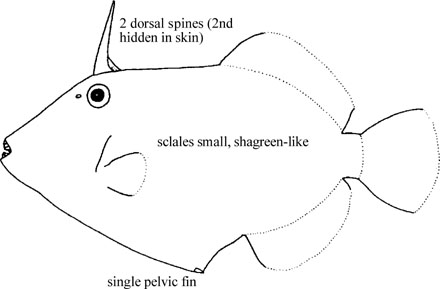MONACANTHIDAE
Filefishes
By Keiichi Matsuura
 Acreichthys tomentosus |
 Monacanthus chinensis |
|
Small or medium-sized fishes, usually less than 20 cm (but up to 50 cm for some species of Aluterus), with deep, highly compressed body covered by thin but rough or shagreen-like skin with minute scales not individually easily discernible to the unaided eye. Mouth small and usually more or less terminal or slightly supraterminal; teeth only moderately heavy, 6 in an outer series in upper jaw and 6 or fewer in the lower. Gill opening a relatively short, vertical to oblique slit in front of pectoral fin base. Two (sometimes 1) dorsal fin spines, second spine not more than 1/3 the length of first; first spine usually capable of being locked in an upright position of erection by the second; dorsal, anal and pectoral fin rays unbranched; pelvic fin and spines rudimentary or absent, represented by a series of 3 or fewer pairs of enlarged scales encasing end of pelvis, or segments of indeterminate number, or entirely absent. Scales above pectoral fin base unmodified, not forming a tympanum. Lateral line inconspicuous or only slightly apparent. Color: variable, drab brown, gray, or greenish, but often with strikingly marked and vivid patterns.
Similar families occurring in the area. Balistidae: III spines in first dorsal fin; skin tough but not shagreen-like, individual scales distinct, usually forming prominent, oblique rows. Triacanthidae: VI spines (usually only V spines visible) in first dorsal fin; pair of strong pelvic fin spines. Remarks. Found in shallow coral and rocky reefs, seagrass beds, and sandy-muddy bottoms in depths of 10 to over 200 m. Feed on coral polyps, epiphytes attached to seagrass, or other marine invertebrates. Marketed fresh. |

|
|